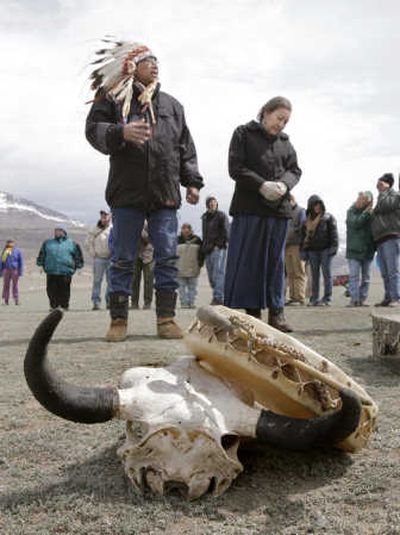Buffalo People honor namesake

GARDINER, Mont. – Kneeling on a sagebrush flat pocked with the footprints of bison recently sent to slaughter from Yellowstone National Park, Lakota spiritual chief Arvol Looking Horse prayed for forgiveness.
“When we first came upon the earth, we were the Buffalo People,” Looking Horse said Tuesday, as a cold wind whipped off the Gallatin Mountains. “We must do what we can to protect the buffalo. Whatever happens to them, happens to us.”
It’s been a bloody year for bison, also known as buffalo, in Yellowstone. Government wildlife agents and hunters have killed or removed a record 1,700 of the animals this winter. Considered a risk to transmit the disease brucellosis to livestock at surrounding cattle ranches, they were captured or shot as they migrated outside the park in search of food.
Federal and state officials cite the lack of an effective brucellosis vaccine and pressure from the livestock industry to contain the disease within Yellowstone.
“It’s impossible to keep the bison in the park when they’re starving there,” Montana Gov. Brian Schweitzer said in an interview this week. “There’s five feet of snow there. That’s the problem.”
As the death toll has climbed, the frustration among American Indians, sporting groups, conservationists and bison advocates has intensified.
Outside a bison holding pen from which another 21 animals had been sent to slaughter that morning, Looking Horse and others opposed to the practice held a ceremony to release the animals’ spirits.
Clad in an eagle feather headdress and stuffing tobacco into a ceremonial pipe, Looking Horse said he hoped to call attention to the bison’s plight to ensure his people’s survival. The Lakota believe their fate is directly linked to that of Yellowstone’s bison.
The park holds one of the last vestigial herds of an animal that once numbered in the millions.
“In the 1800s, when (European settlers) almost wiped out the buffalo and they put us in reservations, our people starved to death,” Looking Horse said. “A handful of buffalo were left. Yellowstone’s are these original buffalo.”
Looking Horse last came to Yellowstone to perform his ceremony during the winter of 1997, when 1,084 bison were killed. Following a public outcry, five state and federal agencies signed an agreement three years later that continued the capture and slaughter program with the promise of a gradual expansion of where bison could roam outside the park.
That expansion has largely not happened. Meanwhile, a plan to develop a vaccine to remove brucellosis from Yellowstone stalled, leaving the park as the last remaining reservoir of the disease in the United States.
Brucellosis can cause pregnant cows to abort their calves. In some states, livestock producers have been forced to spend millions on testing and vaccine programs – on top of the economic losses associated with having tainted herds.
Still, no cases of a bison-to-cattle transmission have been recorded. Outbreaks over the last several years in Wyoming, Idaho and Montana were all traced to elk.
But for ranchers around Yellowstone, the possibility of a transmission is worrisome enough that they’ve fiercely fought efforts to increase where bison can roam.
Among them is Bruce Malcolm, a Republican state lawmaker from Montana who lives 23 miles north of the park. Last year, following a brucellosis outbreak in cattle belonging to his daughter – a herd that originated from cattle at Malcolm’s ranch – federal officials ordered the slaughter of all 600 of her cattle. “I don’t want any bison down here, period,” Malcolm said.
He said the livestock industry has become the “fall guy” for the National Park Service, which Malcolm argued had failed to keep bison numbers low enough that they didn’t pour out of the park every few winters.
Others, including many bison advocates, point at Schweitzer, saying the state Department of Livestock has been the agency most adamant in its defense of the slaughter program.
Schweitzer, in turn, points at the federal government and the ranching industry, saying they’ve blocked his attempts to increase bison habitat and lessen the consequences of a brucellosis outbreak.
At a meeting between Schweitzer and Yellowstone Park Superintendent Suzanne Lewis on Tuesday in Helena, both said they were frustrated with the federal-state agreement that governs the slaughter program.
“We need to find more tolerance for bison in Montana,” Lewis said.